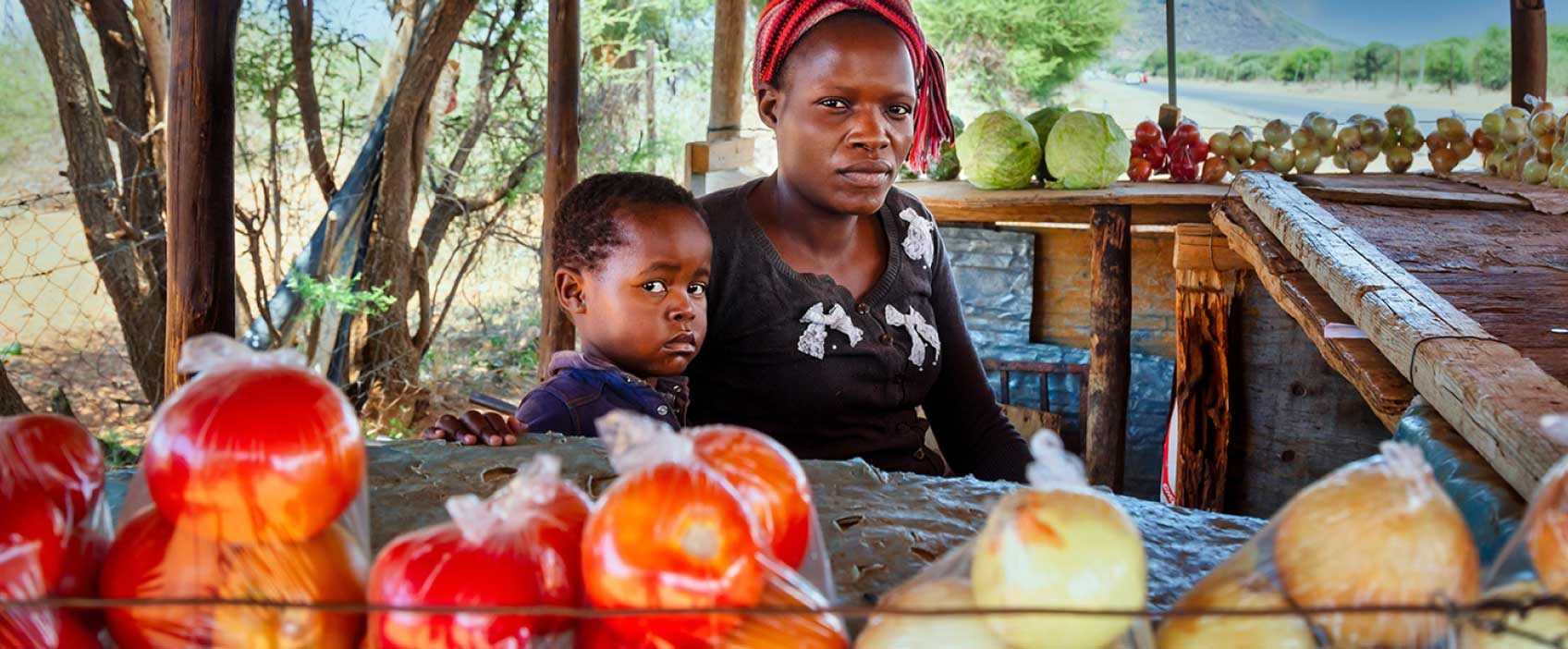
Publications and Datasets
IFPRI publications provide evidence-based insights and analysis on critical issues related to policies for food systems, food security, agriculture, diets and nutrition, poverty, and sustainability, helping to inform effective policies and strategies. Materials published by IFPR are released under a Creative Commons license, and are available for download. IFPRI authors also publish in external sources, such as academic journals and books. Where possible we provide a download link for the full text of these publications.
Featured Publications
Journal Article
Experimental measures of intra-household resource control
2024Ambler, Kate; Jones, Kelly; Recalde, María P.Journal Article
The demographic transition and rural industrialization in China
2024Huang, Qing; Xie, Yu; Zhang, XiaoboJournal Article
Men can cook: Effectiveness of a men’s engagement intervention to change attitudes and behaviors in rural Ethiopia
2025Alderman, Harold; Gilligan, Daniel O.; Hidrobo, Melissa; Leight, Jessica; Mulford, Michael; Tambet, HeleeneExplore Our Latest Publications
By Title By Author By Country/Region By Keyword
Journal Article
Men can cook: Effectiveness of a men’s engagement intervention to change attitudes and behaviors in rural Ethiopia
Working Paper
Would you rather: Voluntary take-up of a poverty graduation program among cash transfer recipients
Journal Article
The technopolitics of agronomic knowledge and tropical(izing) vegetables in Brazil
Journal Article
Sustainability considerations are not influencing meat consumption in the US
Journal Article
Household resilience and coping strategies to food insecurity: An empirical analysis from Tajikistan
Journal Article
Leveraging unsupervised machine learning to examine women’s vulnerability to climate change
Journal Article
Impact of adoption of climate smart agriculture practices on farmer’s income in semi-arid regions of Karnataka
Journal Article
Indicators for monitoring and evaluating research-for-development: A critical review of a system in use
Working Paper
Monitoring the agri-food system in Myanmar: The rising costs of diets – September 2024 survey round
Working Paper
Rice productivity in Myanmar: Assessment of the 2024 dry season
Working Paper
Use of digital tools in Kenya’s potato value chains: Qualitative perspectives from a field visit in Nakuru County
Poster
Understanding the diffusion pattern of potato varieties in India
Training Material
Nigeria school feeding program: Baseline farmers’ survey instrument
Training Material
Nigeria school feeding program: Baseline cooks’ survey instrument
Training Material
Nigeria school feeding program: Train the trainers training manual
Training Material
Nigeria school feeding program: Baseline school administrators’ survey instrument
Report
Myanmar Monthly Food Price Report – October 2024
Training Material
Nigeria school feeding program: Pre- and post-test training quiz questions for cooks
Report
Resilient Cities urban nutrition profile: Philippines
Video
Healthy Diets: Practices, misconceptions, and expert recommendations
Report
Resilient Cities urban nutrition profile: Ethiopia
Report
Resilient Cities urban nutrition profile: Bangladesh
Report
Resilient Cities urban nutrition profile: Sri Lanka
Report
Resilient cities urban nutrition profile: Peru
Report
The socioeconomic impact of armed conflict on Sudanese urban households: Evidence from a National Urban Household Survey
…more
Durrani, Akbar; Nohra, NadaBrief
Nutrition and diet profile: Benin
Brief
Monitoring the agri-food system in Myanmar: Agricultural crop traders – June 2024 survey
Report
IFPRI Malawi maize market report, October 2024
Working Paper
Rural-urban diet convergence in Bangladesh
Working Paper
Medium-scale livestock farms in Asia’s rapidly transforming food systems
Working Paper
Adapting to climate change: The case of saline tolerant seed varieties in coastal Bangladesh
Working Paper
Gendered drivers of varietal turnover: A qualitative assessment for improved teff and wheat varieties in Ethiopia
Brief
Challenges for private sector job matching in rural Egypt: Results from a survey of Forsa employers
Dataset
Nature+ Quantitative Baseline Household & Worker Survey, Kenya
Dataset
Nature+ Quantitative Baseline Household and Worker Survey, Viet Nam
Journal Article
A framework for cost-effectiveness analysis of greenhouse gas mitigation measures in dairy industry with an application to dairy farms in China
Journal Article
Crowding in private quality: The equilibrium effects of public spending in education
Journal Article
Computer vision–assisted dietary assessment through mobile phones in female youth in urban Ghana: Validity against weighed records and comparison with 24-h recalls
…more
Folson, GloriaBrief
Food environment research in Sri Lanka: A desk review
Brief
Improving resource targeting in Niger: Joint financial analysis and food system mapping
Journal Article
Africa pathway to food systems transformation: Challenges and opportunities
Journal Article
Experimental measures of intra-household resource control
Journal Article
How do women’s empowerment metrics measure up? A comparative analysis
Journal Article
Mobile phones, income diversification, and poverty reduction in rural Bangladesh
Journal Article
Subjective well-being, willingness to accept COVID policies, and vulnerability: Evidence from China
Journal Article
Restoring functional integrity of the global production ecosystem through biological control
…more
Hadi, Buyung A.R.Journal Article
Endogenous technologies and productivity in rice production: Roles of social instability in Myanmar since 2021
Report
Impact evaluation of the economic inclusion programme in Kenya: Baseline report for cohort 2
Working Paper
Challenges and opportunities in Nigeria’s home-grown school feeding program: Toward a more efficient and sustainable model
Working Paper
Targeting social assistance in fragile settings: An experiment on community-based targeting
Manual
Survey instrument on beneficiaries’ perceptions of the benefits of the Baxnaano safety net program in Somalia
Training Material
In-depth interview guide on stakeholders’ perceptions of the Baxnaano Safety Net Program benefits in Somalia
Working Paper
Community and household shocks: Findings from the seventh round of the Myanmar Household Welfare Survey (January–June 2024)
Report
Changing the equation: Leveraging true cost accounting to accelerate agri-food systems transformation
Report
Myanmar Monthly Food Price Report – September 2024
Working Paper
Irrigation schemes in Ethiopia’s Awash River Basin: An examination of physical, knowledge, and governance infrastructures
Working Paper
Systematic risk profiling: A novel approach with applications to Kenya, Rwanda, and Malawi
Report
Integrated and enhanced datasets on food security and household coping strategies in the G5 Sahel Countries (2018-2023)
Brief
Papua New Guinea food price bulletin: October 2024
Brief
Synopsis: Enhancing rural income diversification in Rwanda: Opportunities and challenges
Journal Article
Revolutionising multi-sectoral nutrition policy: Insights from the Ethiopian National Information Platform for Nutrition (NiPN) approach
…more
Halala, Yoseph; Zewdu, Frezer; Sinamo, Sisay; Tsegaye, Daniel; Neu, Ingo; Mirsaidova, Manzura; Sarkar, Archana; Tessema, Masresha; Hafebo, Aregash SamuelBrief
Impact of COVID-19 on food security and cropping patterns in Tajikistan: Evidence from a telephone survey in Khatlon Province
Report
IFPRI Malawi Monthly Maize Market Report, September 2024
Working Paper
How have foreign exchange market distortions and conflict affected agricultural production incentives in Myanmar?
Book
2024 annual trends and outlook report: Advancing the climate and bioeconomy agenda in Africa for resilient and sustainable agrifood systems
Data Paper
2022 Social Accounting Matrix for Colombia: A Nexus Project SAM
Dataset
Survey of Micro, Small, and Medium Enterprises in Agri-Food Value Chains: Network-Based Recruitment Approach in Uganda
Dataset
Survey of Micro, Small, and Medium Enterprises in Agri-Food Value Chains: Network-Based Recruitment Approach in Bangladesh
Book Chapter
Dietary quality and nutrition: Past progress, current and future challenges
Book Chapter
Women and youth in agriculture
Book Chapter
Agrifood trade
Book Chapter
Regional variations in rural livelihoods: Challenges and opportunities
Book Chapter
Agricultural land: Inequality and insecurity
Book Chapter
A historical and regional perspective on Myanmar’s agrifood system
Book Chapter
The agrifood system: structure and contribution to development goals
Book Chapter
Crop production: An engine in need of an upgrade
Book
Myanmar’s agrifood system: Historical development, recent shocks, future opportunities
Book Chapter
Income diversification and the rural nonfarm economy
Book Chapter
Conclusion: From recovery to renewal of the agrifood system
Book Chapter
Agricultural mechanization: Drivers and characteristics
Book Chapter
Agricultural value chains: Examples of quiet transformation
Book Chapter
Introduction [in Myanmar’s agrifood system: Historical development, recent shocks, future opportunities]
Book Chapter
Livestock, capture fisheries, and aquaculture: Status and recent trends
Book Chapter
Vulnerability and welfare during multiple crises
Book Chapter
Food processing: A stalled transformation
Book Chapter
Farm commercialization: A transformation on hold or in reverse?
Book Chapter
The rice sector
Book Chapter
Migration trends and implications
Data Paper
2021 Social Accounting Matrix for Guatemala: A Nexus Project SAM
Data Paper
2022 Social Accounting Matrix for Malawi: A Nexus Project SAM
Data Paper
2022 Social Accounting Matrix for Ghana: A Nexus Project SAM
Report
Does location matter? A spatial analysis of the factors influencing adoption of cereal-legume intercropping among smallholder farming households in Malawi
Working Paper
Evaluation of the programme to reduce vulnerability in coastal fishing areas in Djibouti: Qualitative findings
Working Paper
Farming for the future: Prioritization of climate-smart agriculture technologies in SAARC countries
Opinion Piece
Crafting combinations to govern groundwater: Knowledge, motivation, and agency
Working Paper
MSMEs in the Food Environment in urban and peri-urban Ethiopia
Working Paper
Understanding the organizational approaches of funders and project implementers to strengthen women’s empowerment through agricultural collectives
Book Chapter
The Impact of climate change on agriculture
Book Chapter
Climate risks and vulnerabilities in African agrifood systems
Book Chapter



